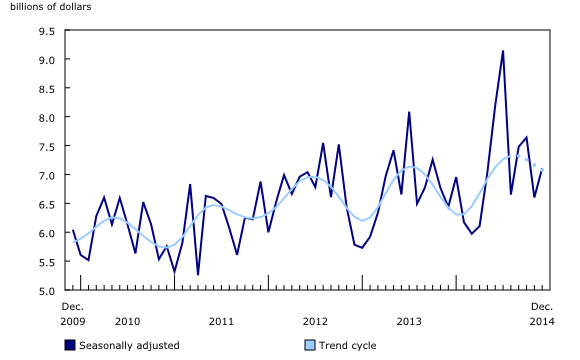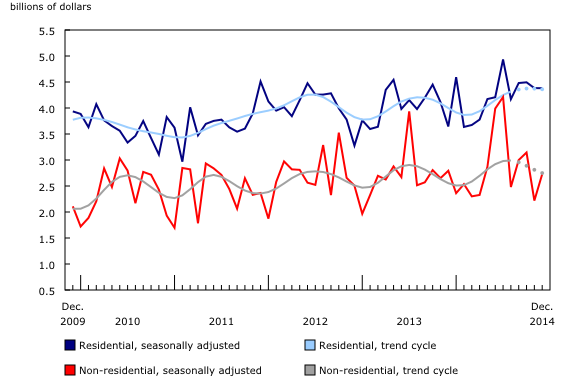Building permits, December 2014
Archived Content
Information identified as archived is provided for reference, research or recordkeeping purposes. It is not subject to the Government of Canada Web Standards and has not been altered or updated since it was archived. Please "contact us" to request a format other than those available.
Released: 2015-02-06
Contractors took out building permits worth $7.1 billion in December, up 7.7% from November. This followed a 13.6% decline the previous month. The increase in December resulted mostly from higher construction intentions in the non-residential sector in Alberta and British Columbia.
The total value of building permits for 2014 was up 5.2% from 2013 to $85.1 billion.
The value of non-residential building permits rose 22.9% to $2.7 billion in December, following a 29.4% decrease in November. Alberta was responsible for most of the monthly increase at the national level, followed by British Columbia. Declines were recorded in five provinces, with Saskatchewan posting the largest decrease.
Between January and December 2014, municipalities issued non-residential building permits worth $34.2 billion, an increase of 5.4% from 2013.
In the residential sector, the value of permits was unchanged at $4.4 billion in December, following a 2.5% decrease in November. Gains were posted in seven provinces, led by Alberta, British Columbia and Quebec. Ontario posted the largest decrease, following a 16.9% gain the previous month. Saskatchewan and Manitoba also registered declines.
Overall for the year, the value of residential building permits totalled $50.9 billion, up 5.1% from the total value in 2013.
Non-residential sector: Double-digit increases in all three components
Canadian municipalities issued commercial building permits worth $1.4 billion in December, 21.2% more than in November. This followed a 25.0% decrease the previous month. The increase was the result of higher construction intentions for a variety of commercial buildings, including office buildings, recreational facilities, hotels and restaurants as well as warehouses. Gains were recorded in six provinces, with Ontario, British Columbia and Quebec posting the largest increases. In contrast, Saskatchewan and New Brunswick reported the largest decreases.
In the industrial component, construction intentions rose 36.5% to $529 million, following a 41.4% decline the previous month. The increase was mainly attributable to higher construction intentions for transportation-related buildings and, to a lesser degree, manufacturing plants. Gains were registered in five provinces, led by Ontario, with British Columbia and Quebec a distant second and third. Manitoba posted the largest decline.
The value of building permits in the institutional component increased 17.7% to $768 million in December, following a 28.4% decrease in November. Alberta, which saw the largest advance, posted a significant increase in construction intentions for educational institutions, while in British Columbia, medical facilities contributed most to the gain. Construction intentions for institutional buildings declined in seven provinces, led by Ontario.
Residential sector: Higher construction intentions for single-family dwellings
Municipalities issued building permits for single-family dwellings worth $2.6 billion in December, up 8.0% from November. Increases were reported in every province, led by British Columbia, Ontario and Alberta.
Construction intentions for multi-family dwellings fell 9.5% to $1.8 billion in December, marking a second consecutive monthly decrease. The decline in December was mainly the result of lower construction intentions in Ontario, followed by Saskatchewan and British Columbia. Gains were registered in five provinces, led by Alberta, followed by New Brunswick and Quebec.
At the national level, municipalities approved the construction of 16,023 new dwellings in December, down 5.6% from November. The decrease came from multi-family dwellings, down 11.9% to 9,550 units. The number of single-family dwellings rose 5.5% to 6,473 units.
Provinces: Large gains in Alberta and British Columbia
The total value of permits was up in seven provinces in December, led by Alberta, followed by British Columbia.
Alberta reported the largest increase, as the value of permits rose 30.7% to $1.7 billion, with higher construction intentions for all types of buildings, most notably for institutional buildings.
British Columbia reported a 20.1% increase to $989 million, the result of higher construction intentions in every component except multi-family dwellings.
The largest decline occurred in Ontario, with institutional buildings and multi-family dwellings accounting for the decrease. Saskatchewan and Manitoba also registered declines.
Higher construction intentions in just over half of the census metropolitan areas
In December, the total value of building permits was up in 18 of the 34 census metropolitan areas.
Edmonton registered the largest gain, followed by Toronto and Vancouver. In Edmonton, higher construction intentions, mainly for institutional buildings and multi-family dwellings, were responsible for the increase. In Toronto, the advance was largely the result of higher construction intentions for industrial buildings, while in Vancouver, the increase came mainly from higher construction intentions for commercial buildings.
Barrie recorded the largest decrease in December, after posting a notable gain the previous month. The decline was the result of lower construction intentions in all components of the residential and non-residential sectors, particularly in multi-family dwellings. Ottawa and Greater Sudbury also registered decreases. In Ottawa, the decline was largely attributable to lower construction intentions for institutional buildings. In Greater Sudbury, institutional and industrial buildings were responsible for the decline.
Note to readers
Unless otherwise stated, this release presents seasonally adjusted data, which facilitates comparisons by removing the effects of seasonal variations. For more information on seasonal adjustment, see Seasonally adjusted data – Frequently asked questions.
The Building Permits Survey covers 2,400 municipalities representing 95% of the population. The communities representing the other 5% of the population are very small, and their levels of building activity have little impact on the total for the entire population.
Building permits data are used as a leading indicator of activity in the construction industry.
The value of planned construction activities shown in this release excludes engineering projects (for example, waterworks, sewers or culverts) and land.
For the purpose of this release, the census metropolitan area of Ottawa–Gatineau (Ontario/Quebec) is divided into two areas: Gatineau part and Ottawa part.
Revision
Data for the current reference month are subject to revision based on late responses. Data for the previous month have been revised.
Trend-cycle estimates have been added to the charts as a complement to the seasonally adjusted series. Both the seasonally adjusted and the trend-cycle estimates are subject to revision as additional observations become available. These revisions could be large and even lead to a reversal of movement, especially at the end of the series. The higher variability associated with the trend-cycle estimates is indicated with a dotted line on the chart.
The December 2014 issue of Building Permits (Catalogue number64-001-X) will soon be available.
The January building permits data will be released on March 6.
Contact information
For more information, contact us (toll-free 1-800-263-1136; 514-283-8300; infostats@statcan.gc.ca).
To enquire about the concepts, methods or data quality of this release, contact Jérémie Bennett (613-951-0793), Investment, Science and Technology Division.
- Date modified:



